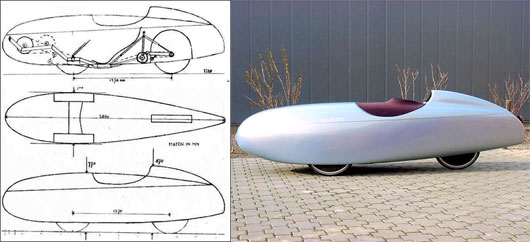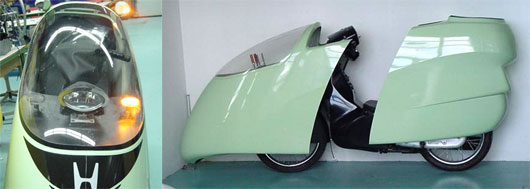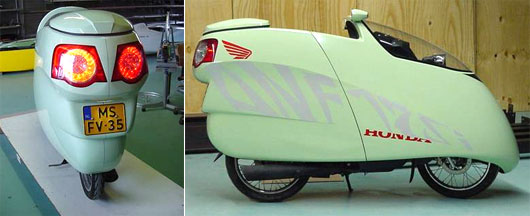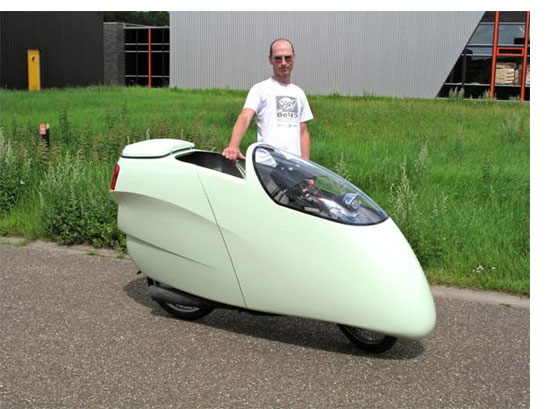
Dutch efficiency enthusiast Allert Jacobs has converted his new Honda motorbike into a streamliner capable of getting over 200 mpg (US) cruising at 55 mph.
The Honda ANF125i Innova was pretty efficient right out of the box, since it followed the basic formula for low fuel consumption: small size + light weight + modest engine power.
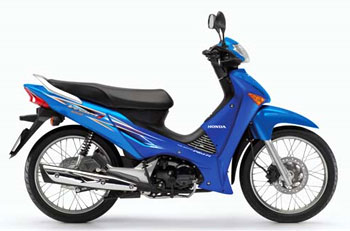 The bike tips the scales at just 231 lbs (105 kg) and features an efficient, fuel injected, four stroke 125cc single, producing 9 hp (6.85 kW).
The bike tips the scales at just 231 lbs (105 kg) and features an efficient, fuel injected, four stroke 125cc single, producing 9 hp (6.85 kW).
With those specs, the Honda already offered great fuel economy: Allert’s first five fill-ups delivered 133 mpg (US) (1.8 L/100 km) over 638 miles (1027 km).
(With a disclaimer: he figures that’s better than “normal” because he was babying the bike while breaking it in. He says a more realistic figure for his driving is 114 mpg (US) – that’s what he got from the last two fill-ups before he started modifying it.)
Q: How do you get from 114 mpg to over 200 mpg?
A: aerodynamics first (and gearing second)
Being a long time cyclist, motorcyclist and velomobile enthusiast, Allert intuitively understands what many people either don’t know or greatly underestimate: the enormous impact of aerodynamics on fuel consumption.
Unlike the average person, he is not surprised by the fact that a typical car burns 50% of its fuel overcoming air resistance at just 40 mph (64 km/h). Or that the higher drag of a typical motorbike means half of its fuel is used to overcome air drag at just 15 – 20 mph (24 – 32 km/h)!
Custom aerodynamic fairing: velomobile influence (version 1)
Allert knew he could significantly reduce the amount of power required to go down the road by lowering the rider’s position (reducing exposure to the oncoming air) and then reducing turbulence by adding smooth fairings.
His extensive experience designing and producing recumbent bicycles and fully enclosed recumbent velomobiles obviously prepared him for this project. (Above photo: Allert’s commercially produced Quest velomobile, a pedal-powered trike)
Diving in feet first
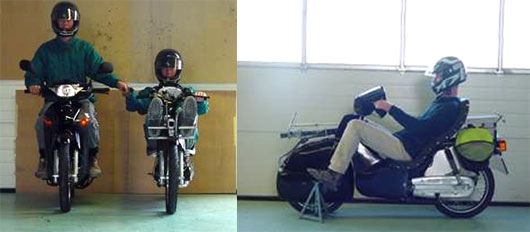
Reducing frontal area showed immediate results. To get a feet-forward position on the Honda, a new seat was mounted in the bike’s step-through area, and the foot pegs and controls were moved to just above the front wheel. The front wheel itself was enclosed, and another fairing was added ahead of the rider.
(Most motorcycle owners have probably experienced the benefit of reducing frontal area and drag, simply by tucking down at higher speeds and feeling the bike speed up without moving the throttle. It’s a good demonstration that shows aerodynamics isn’t only about fuel economy!)
On his first test drive, the drag reduction was obvious. Even lacking critical bodywork needed to smooth airflow at the rear of the bike, the little Honda’s top speed went up from 90 km/h (56mph) to 110 km/h (69mph).
Taller gearing
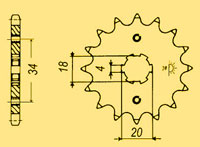 Because the modifed bike now required less energy to go down the road than the stock version, its gear ratios could be optimized: engine RPM could be lowered for a given speed that would have lugged the engine before the aero mods. Reducing engine speed normally improves fuel economy.
Because the modifed bike now required less energy to go down the road than the stock version, its gear ratios could be optimized: engine RPM could be lowered for a given speed that would have lugged the engine before the aero mods. Reducing engine speed normally improves fuel economy.
With the new sprockets in place, fuel economy was now up to 152 mpg (1.55 L/100 km) over 1901 miles of riding (3059 km).
But Allert wasn’t happy! He wanted more…
Lessons learned from version 1
- Stability issues with the front wheel fairing: side winds were affecting stability, because steering force was being transmitted to the forks. “It turned out to be very scary to ride even with as little as 3 Beaufort (about 10mph) side wind. I did not dare to go over 35mph.” That would have to change.
- Manual clutch conversion: with the taller gearing, Allert wasn’t happy with the Honda’s stock semi-automatic shifting. He added a clutch lever & cable and converted to a full manual transmission so he could control the amount of slip needed for a smooth start, since “the first gear is now almost as long as the second gear used to be”.
- Revised aerodynamic fairings: to reach his efficiency goals, the aerodynamics of version 2 would have to be better.
Version 2: best tank = 214 mpg (US); average = 199 mpg
The photos below speak for themselves (click to zoom). Allart spent months crafting full length bodywork, divided in two sections. The front half slides forward in a clever setup that allows the rider to get “in” and “out” of the bike fairly easily.
The windshield is less for forward vision than a place to locate the LED turn signals to keep them out of the wind. Allert added signals on the side mirrors as well.
He’s happy with the stability of the full length fairing compared to the first version: “A 40mph (65 km/h) side wind is no problem,” though more than that he hasn’t experienced yet.
And it works: in cool, windy weather, he managed 214 mpg (US) or 1.1 L / 100 km on a 160 mile (km) round trip. His goal is 235 mpg on a trip cruising at 55 mph (90 km/h). Why 235 mpg? Because its metric equivalent (as is used in the Netherlands) would be a very impressive 1 liter per 100 kilometers.
He expects that’s possible in ideal conditions (warm & calm), though he’s not simply waiting for better weather to accomplish this feat. He notes that the fairing isn’t entirely optimized from an aerodynamic perspective, and is also investigating potential improvements in rolling resistance (by methodologically testing different brands of tires on a custom made test rig).
When spring & summer roll around this year, I have little doubt that 1L / 100 km is in the cards for Allert Jacobs.
We’re looking forward to seeing more from this man!
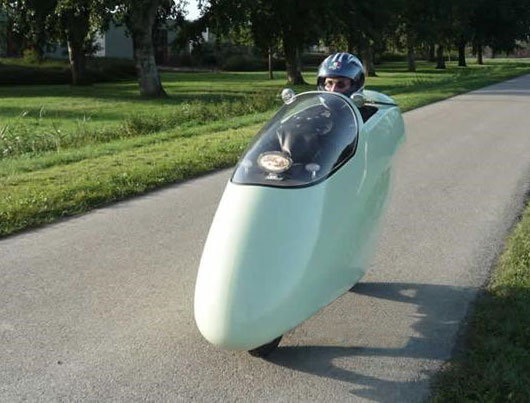
(Photos: Allert Jacobs. Used with permission.)
| Aerodynamics: a weighty matter
Allert Jacobs added 88 lbs / 40 kg worth of aerodynamic modifications to his bike. He admits he didn’t try particularly hard to fabricate light parts, so his Honda now weighs 43% more (!) than it did when he bought it.People who aren’t familiar with the subject of aerodynamics often predict (mistakenly) that the extra weight of aero mods will hurt fuel economy more than reducing drag will help. Obviously that’s not the case here. Aerodynamic improvements trump weight. The exception may be for vehicles that spend the majority of their time in heavily congested urban traffic at very low average speeds. Clearly that’s not Allert’s situation. In fact he figures the added weight on the Honda is a benefit because “it will make it more stable in side wind situations.” |
.
For more information:
- For the latest information & photos, visit Allert Jacob’s web site documenting this project
- Craig Vetter is one of the godfathers of motorcycle efficiency enthusiasts. Read about his own on-going high mileage motorbike project, the Freedom Machine.
- EcoModder member Janvos has been working on similar aero & gearing mods to his Suzuki Burgman. Follow his progress in this project thread.
More projects featuring aerodynamic modifications:
